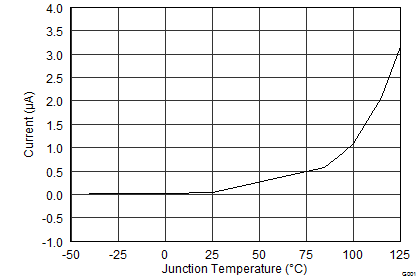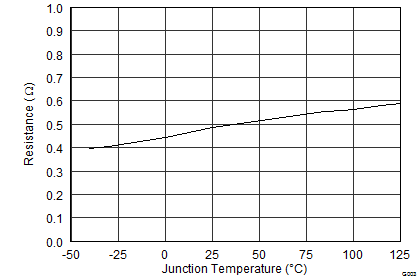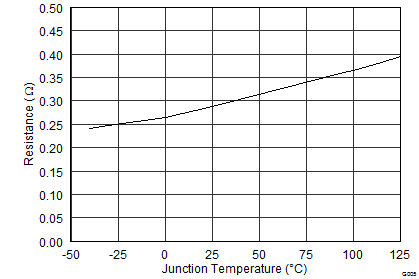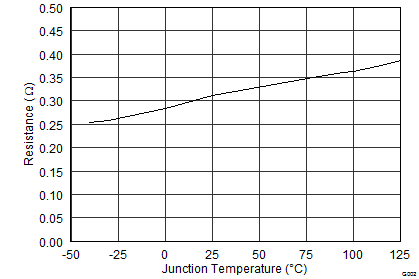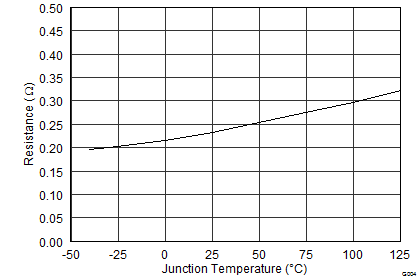SLVSC01A June 2013 – April 2015 TPS65133
PRODUCTION DATA.
- 1 Features
- 2 Applications
- 3 Description
- 4 Typical Application
- 5 Revision History
- 6 Pin Configuration and Functions
- 7 Specifications
- 8 Detailed Description
- 9 Application and Implementation
- 10Power Supply Recommendations
- 11Layout
- 12Device and Documentation Support
- 13Mechanical, Packaging, and Orderable Information
7 Specifications
7.1 Absolute Maximum Ratings(1)
over operating free-air temperature range (unless otherwise noted)| MIN | MAX | UNIT | ||
|---|---|---|---|---|
| Input voltage(2) | PVIN, AVIN, EN, SWP, VPOS | –0.3 | 6 | V |
| VNEG | –6.5 | 0.3 | V | |
| SWN | –6.5 | 5.5 | V | |
| Junction temperature, TJ | –40 | 150 | °C | |
| Storage temperature, Tstg | –65 | 150 | °C | |
(1) Stresses beyond those listed under “absolute maximum ratings” may cause permanent damage to the device. These are stress ratings only and functional operation of the device at these or any other conditions beyond those indicated under “recommended operating conditions” is not implied. Exposure to absolute-maximum-rated conditions for extended periods may affect device reliability.
(2) With respect to GND pin.
7.2 ESD Ratings
| VALUE | UNIT | |||
|---|---|---|---|---|
| V(ESD) | Electrostatic discharge | Human-body model (HBM), per ANSI/ESDA/JEDEC JS-001(1) | ±2000 | V |
| Charged-device model (CDM), per JEDEC specification JESD22-C101(2) | ±500 | |||
(1) JEDEC document JEP155 states that 500-V HBM allows safe manufacturing with a standard ESD control process.
(2) JEDEC document JEP157 states that 250-V CDM allows safe manufacturing with a standard ESD control process.
7.3 Recommended Operating Conditions(1)
over operating free-air temperature range (unless otherwise noted)| MIN | NOM | MAX | UNIT | ||
|---|---|---|---|---|---|
| VI | Input voltage | 2.9 | 3.7 | 5 | V |
| TA | Operating ambient temperature | –40 | 85 | °C | |
| TJ | Operating junction temperature | –40 | 125 | °C | |
(1) Refer to the Application Information section for additional information.
7.4 Thermal Information
| THERMAL METRIC(1) | TPS65133 | UNIT | |
|---|---|---|---|
| DPD (WSON) | |||
| 12 PINS | |||
| RθJA | Junction-to-ambient thermal resistance | 51.5 | °C/W |
| RθJC(top) | Junction-to-case (top) thermal resistance | 41.7 | |
| RθJB | Junction-to-board thermal resistance | 25 | |
| ψJT | Junction-to-top characterization parameter | 0.5 | |
| ψJB | Junction-to-board characterization parameter | 25.2 | |
| RθJC(bot) | Junction-to-case (bottom) thermal resistance | 4.4 | |
(1) For more information about traditional and new thermal metrics, see the IC Package Thermal Metrics application report, SPRA953.
7.5 Electrical Characteristics
VI = 3.7 V, EN = VI, VPOS = 5.0 V, VNEG = –5.0 V, TA = –40°C to 85°C, typical values are at TA = 25°C (unless otherwise noted)7.6 Switching Characteristics
over operating free-air temperature range (unless otherwise noted)| PARAMETER | TEST CONDITIONS | MIN | TYP | MAX | UNIT | |
|---|---|---|---|---|---|---|
| BOOST CONVERTER (VPOS) | ||||||
| Switching frequency | IPOS = 200 mA | 1.2 | 1.7 | 2.2 | MHz | |
| Short-circuit detection time | The delay from when VPOS < V(SCP)(P) to when the boost converter turns off | 1 | 3 | 5 | ms | |
| BUCK-BOOST CONVERTER (VNEG) | ||||||
| Switching frequency | INEG = –200 mA | 1 | 1.7 | 2.4 | MHz | |
| Short-circuit detection time | The delay from when VNEG > V(SCP)(N) to when the inverting buck-boost converter turns off | 1 | 3 | 5 | ms | |
| Start-up delay | The delay from when VPOS has reached its target value to when VNEG starts ramping | 2 | ms | |||
7.7 Typical Characteristics
